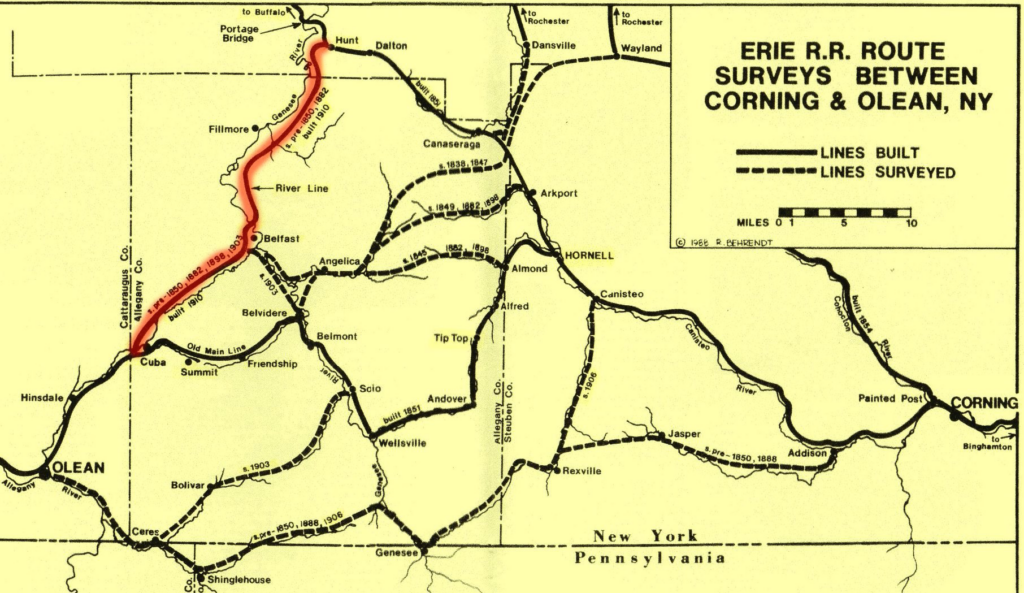
This was a freight-only cut-off from the Buffalo line of the Erie Railroad and the old main line between Binghamton and Dunkirk. It was built to as a bypass to steep grades on the old main line between Hornell and Cuba. It is ten miles longer than the old main line route, but its summit was 200 feet lower (1,560 feet above sea level) and the maximum eastbound grade is 0.2 percent and the maximum westbound grade is 0.3 percent.
Planning for the line began in 1905 when Joseph M. Graham, Chief Engineer, began lobbying for a way to reduce the grades on the main line to reduce the costs of transporting goods through the area. As evidence, he cited the fact that during the 12-month period ending June 30, 1905 the Erie operated 14,558 helper movements to assist 2,228 passenger trains in each direction, 4,084 eastbound freight trains, and 3,574 westbound freight trains. Graham estimated the the line would cost $3.5 million to construct; the actual cost was closer to $7 million.
After several arduous and costly years of building, the new 32-mile “River Line” opened in 1910, so named for the Genesee whose valley it followed from Hunt to Belfast.
The Erie Railroad organized and incorporated the Genesee River Railroad in 1905 to purchase the land and build the tracks. The Genesee River Railroad was officially merged into the Erie Railroad on February 17, 1915.
Genesee Viaduct
The line was noted for two large bridges: The Genesee Viaduct and the Rush Creek Viaduct. The Genesee Viaduct, over the Genesee River, was 3,120 feet long and 141 feet high. It was built built in 1906-1907 by the Willard Construction Company across the Genesee River near Belfast, NY. The bridge stands on 24 towers, each supported by two concrete bases 40 feet square and 80 feet tall. The total cost of the materials was $110,000. According to legend, an Italian worker was buried alive when a portion of the western end of the trestle was filled in with dirt. The Italian workers could not speak enough English to communicate what was happening to their Anglo-Saxon foremen and the unfortunate worker was buried and never found.


Rush Creek Viaduct
The Rush Creek Viaduct, over the Genesee’s tributary Rush Creek, was 1,920 feet long and 155 feet high. The soil in this area is a slimy sort of loam and the track had a tendency to slip down. To combat this, the railroad planted trees and vines, particularly Japanese Honeysuckle, on the slopes.

Locations
As a freight-only line there were no passenger stations, but there were a number of towns and named locations along the line.
| Distance From C B Junction | Location | Distance From Jersey City |
| 32.6 25.4 19.7 12.9 6.3 0.0 | River Junction Fillmore Shongo Belfast Black Creek CB Junction | 358.1 365.3 371.0 377.8 384.4 390.7 |
Clippings
More Information
- Erie’s River Jct. line (near Swains). From the railroad.net forums.
- Post on the Facebook Boliver New York Fan Page
- Second post on the Facebook Boliver New York Fan Page